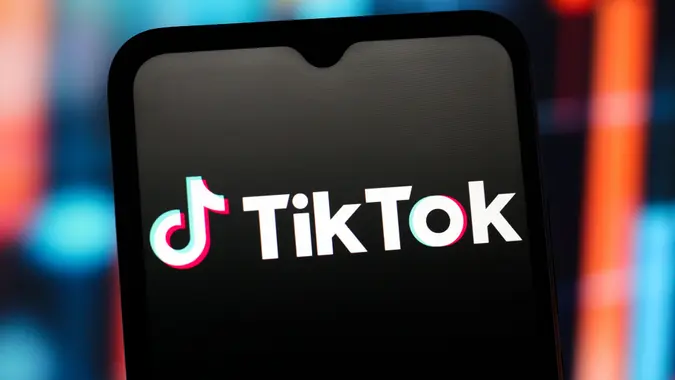Personal Loan vs. Line of Credit: Which One Fits Your Needs?

Commitment to Our Readers
GOBankingRates' editorial team is committed to bringing you unbiased reviews and information. We use data-driven methodologies to evaluate financial products and services - our reviews and ratings are not influenced by advertisers. You can read more about our editorial guidelines and our products and services review methodology.

20 Years
Helping You Live Richer

Reviewed
by Experts

Trusted by
Millions of Readers
You need to borrow money, and you’ve narrowed the options down to a personal loan or a line of credit. Only, you aren’t sure which one is right for your situation.
Personal loans let you borrow a lump sum of money that you pay back with interest, over a set term. A personal line of credit, on the other hand, works more like a credit card. You have a set credit limit you can withdraw from as needed, and you’ll only pay interest on the amount you borrow.
So, which is better? Here’s a closer look at how to choose between a personal loan vs. line of credit.
Quick Comparison: Personal Loan vs. Line of Credit
A personal loan and a personal line of credit let you borrow when you need cash, but they work differently. Here’s an at a glance comparison of each one’s key features.
| Feature | Personal Loan | Line of Credit |
|---|---|---|
| How you get money | One lump sum, in a paper check or deposited to your bank account | Withdraw funds as needed using a debit card, paper checks or electronic transfers |
| Interest rate | Typically fixed | May be fixed or variable |
| Fees | Origination fees, late payment fees, prepayment penalties | Origination, fees, annual fees, transaction fees |
| Repayment | Fixed monthly payments | Flexible payments |
| Best for | One-time large expenses | Ongoing or unpredictable costs |
What can you use a personal loan or line of credit for? Common uses include:
- Debt consolidation
- Medical bills
- Home improvements or repairs
- Veterinary expenses and pet care
- Wedding expenses
- Large purchases, like appliances or furniture
- School expenses
- Business expenses
You could also use a personal loan or line of credit to get through a financial emergency, such as a job loss or an unexpected car repair. Either borrowing option gives you the freedom to decide how to put the money to work.
Pros and Cons of Personal Loans
Personal loans allow you to borrow a lump sum, typically with no collateral needed.
| Pros | Cons |
|---|---|
| Predictable monthly payments make budgeting easier. | You’re locked into borrowing a fixed amount, even if you don’t need it all. |
| Personal loans often have lower interest rates than credit cards. | Some lenders charge fees for early repayment |
| Great for large, one-time expenses like debt consolidation or home improvement |
When Does a Personal Loan Make Sense?
Assume you owe $20,000 to three credit cards, with an average annual percentage rate (APR) of 21%. Your monthly minimum payment is $500. At that rate, it will take you 70 months to pay off your debt and cost you $14,700 in interest.
You decide to:
- You take out a $20,000 personal loan at 12% APR with a five-year term.
- You use the loan to pay off your credit cards.
- Your new monthly payment is $445.
In this instance, getting a personal loan for debt consolidation streamlines your budget, lowers your monthly payment, and cuts your interest paid by more than half.
Pros and Cons of a Line of Credit
A personal line of credit is a revolving credit line that you can use as needed.
| Pros | Cons |
|---|---|
| Borrow only what’s needed and pay interest only on what’s used | Variable interest rates can make payments unpredictable |
| Ideal for irregular expenses or emergencies | It can lead to overspending if not managed carefully |
| Offers flexibility for self-employed individuals or those with variable income |
Here’s an example of how a personal line of credit can fill financial gaps in uncertain situations.
Your situation:
- You’re a self-employed freelance writer.
- Work is steady most of the year, but client work dries up during summer months.
- You need $4,000 per month to cover expenses.
- You have some savings but prefer not to deplete it entirely.
Your solution:
- You open a $20,000 personal line of credit with a 12% APR.
- You use $6,000 from the credit line to cover living expenses.
- You supplement the rest with your savings.
Repayment plan:
If you charge nothing else and pay $285 per month, you’ll clear the balance in 24 months.
How To Decide Which Is Right for You
Should you choose a personal loan vs. a personal line of credit? The answer is, well, personal. Here are some tips to help you decide which one to choose.
1. Assess Your Need
Do you know how much you need to borrow? If you have a set dollar amount in mind, a personal loan could make sense. On the other hand, a personal line of credit can offer some wiggle room if you don’t have an exact figure.
2. Check Your Credit
For most lenders, personal loan requirements include good credit and steady income. Reviewing your credit reports and scores can give you an idea of what you’ll likely qualify for.
If your score is on the lower side, you may need to look into personal loans for bad credit. Keep in mind that you pay pay a higher interest rate to borrow.
3. Calculate Your Debt-To-Income (DTI) Ratio
Debt-to-income or DTI measures how much of your income goes to debt repayment each month. The lower this number is, the easier it may be to get a personal loan or line of credit.
Here’s how to calculate debt-to-income ratio: divide the total of your monthly debt payments by your gross monthly pay, and multiply the result by 100.
4. Consider the Costs
Personal loans and lines of credit may have fees, on top of the interest you pay. Comparing rates and fees for loans and lines of credit offered by different lenders can help you estimate your potential cost to borrow. Generally, it’s helpful to get rate quotes from a minimum of three lenders.
5. Review Your Budget
You’ll need steady income to make personal loan payments or repay a line of credit. Look at your budget and income to decide if a fixed payment would be preferable, or whether you’re comfortable with a payment that might change from month to month. If you have irregular income because you’re self-employed or do gig work, a line of credit could be more accomodating to a changing budget.
Try This
Talk to a financial advisor or lender to explore the best option for your needs.
Final Thoughts
Personal loans and lines of credit have their strengths, and they can meet financial needs across a variety of situations. Understanding how each one works, what they’re best used for and what you need most can help you decide which option is right for you.
Learn more about borrowing options by exploring guides on personal loans and lines of credit on GOBankingRates.
FAQ
- Which has a lower interest rate, a personal loan or a line of credit?
- It can depend on the lender and your credit history. Personal loans often have low, fixed rates while a line of credit may have higher, variable rates.
- Can I use a line of credit like a credit card?
- Yes. A line of credit is similar to a credit card, since you draw against your credit line as needed and repay what you borrow with interest.
- How do I qualify for a personal loan or a line of credit?
- Qualifying for a personal loan or line of credit means meeting a lender's minimum requirements for credit scores, income and debt-to-income ratio.
- Is a personal loan or line of credit better for emergencies?
- A line of credit is often better for emergencies because you can borrow just what you need, and approval times may be faster.
- How does a personal loan or line of credit affect credit scores?
- Applying for a personal loan or line of credit can knock a few points off your credit scores. Repaying your loan or line of credit on time can help you get those points back.
Barb Nefer contributed to the reporting for this article.
 Written by
Written by  Edited by
Edited by 





















